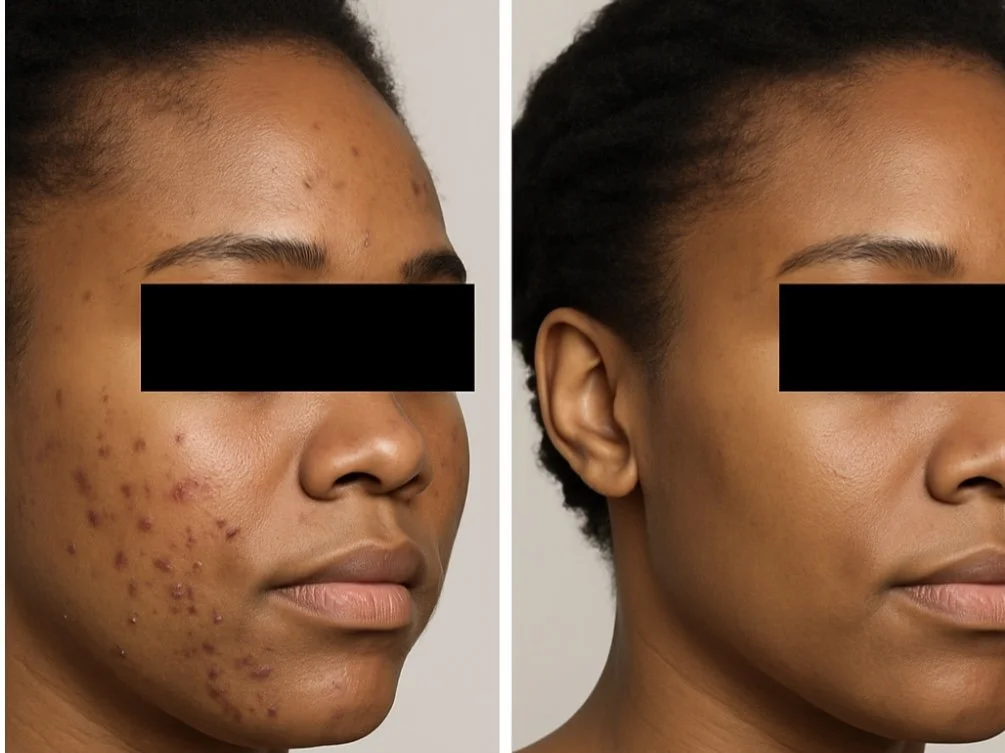Acne is not your failure.
It’s a medical condition.
And medical conditions deserve real medical treatment.
Before and After Result with Prescription Acne Ingredients
Medications We Prescribe for Acne
-

Tretinoin
The gold standard for acne — speeds up cell turnover, clears pores, and prevents new breakouts.
-

Adapalene
A gentle, prescription retinoid — a gentler prescription retinoid that calms inflammation and keeps pores clear.
-

Azelaic Acid
A Multitasking cream — reduces redness, fights acne bacteria, and helps fade post-acne marks.
-

Niacinamide
A skin-calming powerhouse — a skin-calming powerhouse that strengthens the barrier, balances oil, and soothes irritation.
Your Skin Doesn’t Have to Face Breakouts Alone.
-
What is acne, really?
Acne isn’t a phase — it’s inflammation. And for many people, it’s chronic.
When you break out, it’s not because you “failed” skincare or skipped a step. Acne starts when pores get clogged by oil and dead skin cells — often driven by hormones, genetics, or inflammation under the surface. It’s not fixed by gimmicks. It needs targeted prescription treatment that addresses the real causes. -
What medications will I be prescribed?
Based on your SmartForm™ answers, you will be prescribed:
Tretinoin 0.01%–0.1% — the gold-standard retinoid for acne. Adjusted to your tolerance and skin type. Most patients start lower and increase as needed.
Adapalene 0.1%–0.3% — a gentler retinoid option for steady, long-term acne control or sensitive skin.
Azelaic Acid 15%–20% — reduces redness, calms inflammation, and helps fade post-acne marks.
Niacinamide 4%–10% — supports barrier strength, balances oil, and reduces irritation.
📌 Nearly every acne plan begins with a retinoid prescription (tretinoin or adapalene). The exact strength and add-ons are chosen for you.
-
What to expect — and when.
Weeks 0–4 – Skin adjusts. Some dryness or mild purge is normal.
Weeks 4–8 – Breakouts settle. Less inflammation, fewer active pimples.
Weeks 8–12+ – Skin stabilizes. Fewer new breakouts. Steadier, supported skin.
Everyone’s timeline is a little different, but most people notice clearer, calmer skin within the first 2–3 months as the prescription builds long-term results.
Ready to treat your acne —
with real medical care
FAQs
-
Acne isn’t just a teenage problem. Adult acne is common and often tied to hormones, stress, or skin barrier disruption. It needs a treatment plan that targets your skin’s current state — not your high school routine.
-
Yes. We prescribe medications that reduce inflammation and oil production while calming hormonal flare-ups. Cystic acne often needs a stronger, prescription-only approach — and our SmartForm™ intake helps flag when advanced in-person care is likely needed.
-
Yes — we adjust your treatment based on your skin tone, sensitivity, and tolerance. Our approach helps reduce risk of dryness, hyperpigmentation, and irritation.
-
Most drugstore acne products rely on lower-strength ingredients like salicylic acid or benzoyl peroxide. We use prescription-grade medications proven to work faster and more effectively — without relying on trends or cosmetic fillers.




